COMEX Deliverable Silver Far Less Than Imagined
Back in April 2020 during the LBMA-COMEX gold crisis of 2020, when gold prices on COMEX diverged nearly $100 higher than gold prices in London, and the LBMA and CME (COMEX) rushed out multiple combined statements trying to assure the market about “healthy gold stocks in New York and London” (while at the same time scrambling to send shipments of gold bars from London to New York), there appeared some intriguing correspondence between the CME and the Commodity Futures Trading Commission (CFTC).
Specifically, that correspondence (which was a submission by the COMEX to the CFTC certifying a doubling in ‘position limits’ on gold futures trading from 3000 contracts to 6000 contracts) contained the bombshell admission that 50% of the ‘Eligible’ gold in the COMEX-approved vaults in New York should be subtracted from ‘Deliverable Supply’ since that portion of gold in the ‘Eligible’ category is held by long-term investors and has nothing to do with COMEX gold futures trading. For background see the BullionStar article “COMEX Bombshell – Most eligible vaulted gold has nothing to do with COMEX” from 16 April 2020.
So instead of all the gold in the COMEX approved vaults (i.e. total of ‘Registered’ category and ‘Eligible’ category gold) being available to back COMEX gold futures trading, the CME was saying no, the estimated deliverable supply of gold is equal to ‘Registered’ + 0.5 (‘Eligible’).
To put the LBMA silver vault hemorrhage into context, during one month (September), LBMA London vaults lost more silver (45,166,000 troy ounces) than is in the entire COMEX Registered category (40,150,447 troy ounces). If silver buyers turn their attention to COMEX, then boom!? pic.twitter.com/iw1Ht06osZ
— BullionStar (@BullionStar) October 7, 2022
Eligible, Registered and Deliverable
For anyone confused about the COMEX ‘Eligible’ and ‘Registered’ categories of inventories, join the club. Nearly everyone has been, at one time, confused by these terms. So here is a quick tutorial, straight from the horse’s mouth of the CME:
“Eligible metal is metal that is acceptable for delivery against the Contract (i.e., which meets the specifications and approved brands of the Contract) for which a warrant has not been issued.”
“Registered metal is eligible metal for which a warrant has been issued.”
“COMEX warrants are classified as electronic documents of title under the Uniform Commercial Code (UCC) and are issued by Exchange-approved COMEX depositories.
Each warrant is registered at the Exchange and linked to specific bars with identifiable and unique warrant numbers traceable to each COMEX depository.”
Also: “COMEX depositories” = COMEX approved vaults = COMEX approved warehouses.
You might ask where I’m going with this? Where I’m going with this is Silver.
Because while COMEX operator (the CME) revealed its hand about the COMEX deliverable gold supply in April 2020 during the initial panic phase of the LBMA-COMEX gold crisis, it also turns out that the CME also revealed its hand about the COMEX deliverable silver supply during the initial panic phase of the LBMA-COMEX silver crisis, a.k.a. the beginning of the #SilverSqueeze frenzy in February 2021.
Just attended the annual LBMA (Gold) conference in Lisbon. Polling takeaways from delegates: they are mildly bearish Gold for the year ahead ($1830 by 2023s conference) but super bullish Silver ($28.30!) as the focus was on physical tightness driven by unprecedented demand
— Nicky Shiels (@nixsa84) October 19, 2022
Silver Bombshell – Deliverable Supply with 50% Haircut
And what the COMEX operator CME revealed about deliverable silver in February 2021 was as equaling startling as what the CME revealed about deliverable gold in April 2020.
The February 2021 eligible silver revelation also came in a submission by the CME to the CFTC (dated 19 February 2021) certifying a doubling in ‘position limits’, this time on its silver futures contracts, from 1500 contracts to 3000 contracts. The CME 5000 oz silver futures contract (contract specs) is the world’s most traded silver futures contract and it is physically deliverable in “five (5) bars of refined silver cast in bars of one thousand (1,000) troy ounces”.
For whatever reason, this February 2021 CME submission (which had great timing by the CFTC and CME in being tee’d up just as #SilverSqueeze threatened to jettison the silver price a lot higher) seems to have gone under the radar until now and has not been mentioned anywhere as far as I can see, but it is critical in highlighting given the massive outflows of physical silver which we are currently seeing from both the LBMA vaults in London, and the COMEX Registered silver category in COMEX New York.
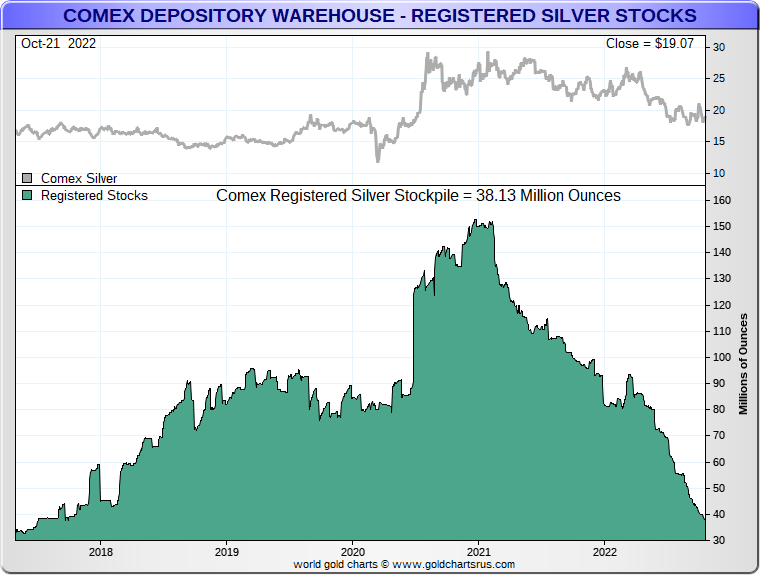
Why? Because those that say that COMEX silver inventories are not just Registered silver but also include Eligible silver, are not seeing the full picture.
50% Haircut – Now you See It, Now you Don’t
In its February 2021 submission, the CME included “an updated analysis of deliverable supply in connection with the increased position limits for the Silver Futures contract” which it attached as Appendix C to its submission, and which can be seen on the CME website here, and on the CFTC website here.
In this Appendix C, which has a full title of “Commodity Exchange, Inc. (“Comex”) Analysis Of Deliverable Supply Silver Futures”, the CME states that:
“the key component in estimating deliverable supply is the portion of typical depository stocks that could reasonably be considered to be readily available for delivery.”
And then goes on to quote the CFTC’s definition of deliverable supply as:
“the quantity of the commodity meeting the contract’s delivery specifications that can reasonably be expected to be readily available to short traders and saleable by long traders at its market value in normal cash marketing channels at the derivative contract’s delivery points during the specified delivery period, barring abnormal movement in interstate commerce.”
For COMEX silver, the 10 delivery points, or ‘approved silver depositories’, on the date the CME document was written (19 February 2021) were Brinks, CNT, Delaware Depository, HSBC Bank, IDS Delaware, JP Morgan Chase Bank, Malca-Amit, Manfra, Tordella & Brookes (MTB), Loomis, and Bank of Nova Scotia.
As of October 2022, all of these silver depositories are still approved by COMEX, with the exception of the Bank of Nova Scotia (which withdrew its vault from being COMEX approved on 1March 2021).
Like its Eligible Gold bombshell in the April 2020 document, the Eligible Silver bombshell in the CME’s February 2021 document stated that:
“The Exchange recognizes that silver is used as an investment vehicle and as such some silver stock may be held as a long-term investment.”
Because of this, states the February 2021 CME submission:
“the Exchange, in an effort to represent a conservative deliverable supply that may be readily available for delivery, made a determination to discount from its estimate of deliverable supply 50% of its reported eligible silver at this time.”
COMEX #SILVER VAULTS DROP TO 304.1 MILLION OUNCES – LOWEST LEVEL SINCE JUNE 19, 2019
– Registered unchanged at lowest level since Sept. 28, 2017.
– Open Interest now equal to 226% of all vaulted silver and 1,802% of Registered silver. pic.twitter.com/QCNtMeDCct— Michael ?️? #silversqueeze (@mikesay98) October 21, 2022
Running the Numbers
Taking the CME’s estimate of ‘Deliverable Silver Supply’ (which uses a 50% haircut for Eligible silver), and plugging in the data from the latest COMEX silver inventories report (dated 21 October 2022) we see the following.
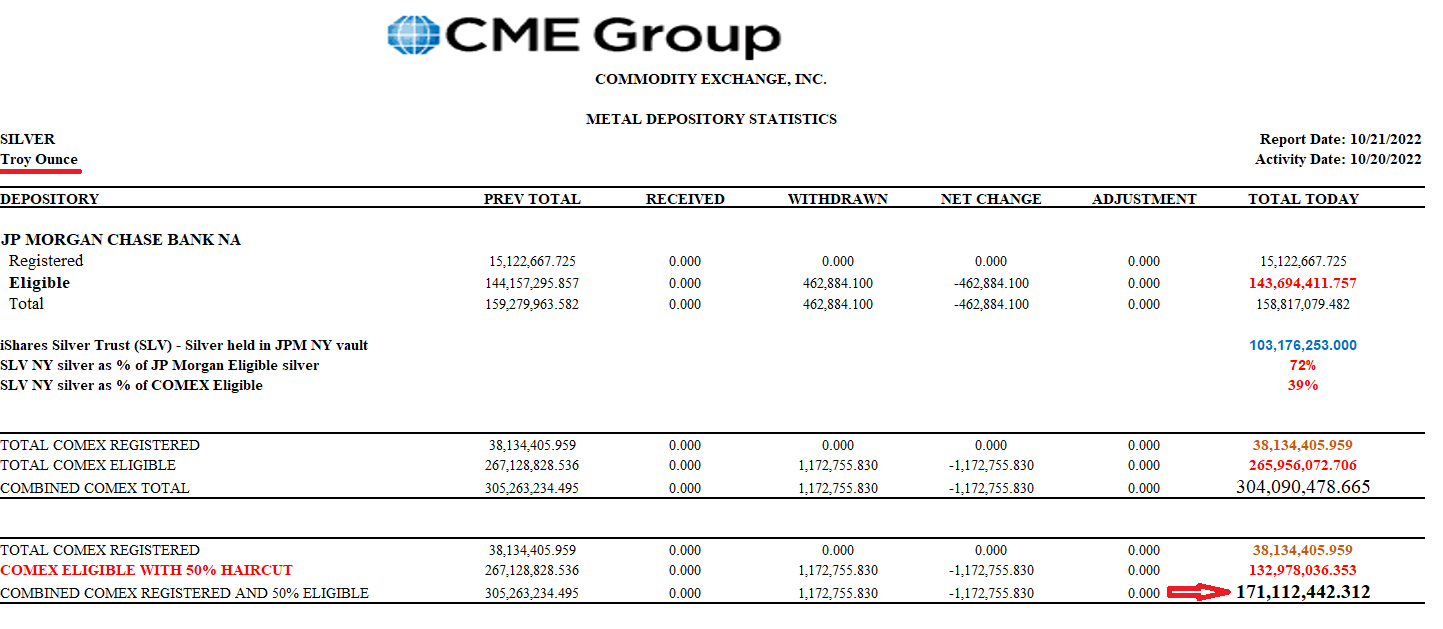
In terms of the overall COMEX total of Eligible silver reported on 21 October 2022, this was 265,956,072 ozs. The Registered silver inventory, which is at a 5 year low, was 38,134,406 ozs. The Eligible silver total (as reported by COMEX) was 265,956,073 ozs.
Raw data from COMEX – 21 October 2022
Registered silver inventory 38,134,406 ozs
Eligible silver inventory 265,956,073 ozs
Total silver inventory 304,090,479 ozs
COMEX Eligible with a 50% Haircut – 21 October 2022
Registered silver inventory 38,134,406 ozs
50% Eligible silver inventory 132,978,036 ozs
Total silver inventory 171,112,442 ozs
This 171.1 million ozs is equivalent to 34,222 COMEX ‘5000 oz’ silver contracts. And so an individual position limit of 3000 contracts (e.g. held by a bullion bank) represents a massive 11.4% of COMEX deliverable silver supply.
So will the CFTC now instruct CME to lower COMEX silver position limits again? So as to prevent single trading entities having too much influence over silver “price discovery"?
Tamp it Down?
As an article on the legal website JD Supra, written by K&L Gates LLP and Michael G. Lee explains why it is so important to have realistic position limits. It also raises some questions on why the CFTC raised position limits for gold and silver in April 2020 and February 2021, respectively, and in doing so made it easier for ‘unduly controlling’ those markets:
“The CEA [Commodity Exchange Act] empowers the CFTC to limit the number of derivative contracts that can be owned by any one person or group in order to prevent derivatives from being used to exercise undue control on a market, which can cause sudden or unreasonable fluctuations in price.
Furthermore, through the Dodd-Frank Act, Congress charged the CFTC to update its regulations on position limits to prevent excessive speculation and manipulation while ensuring sufficient market liquidity for bona fide hedgers and protecting the price discovery process."
Or will the CFTC maintain the 3000 contract position limit, so as to allow the silver price to be tamp down, as the CFTC’s chairman Rostin Behnam said in March 2021. And I quote:
“And in many respects, the resiliency and the market structure of the futures market were really able to TAMP DOWN what could have been a much worse situation in the SILVER market."
See actual video segment here also:
Technically, the CFTC cannot lower position limits on silver, because the latest limit of 3000 has been hardcoded into the ‘Final Ruling’ on position limits for derivatives. The limit is actually “>3000". See table on the CFTC website here.
But back to Eligible silver. why does the CME stop at a 50% discount for Eligible Silver? The CME February 2021 letter to the CFTC even concedes that:
“surveys conducted indicated no clear consensus as to how much silver is dedicated to long term investments.”
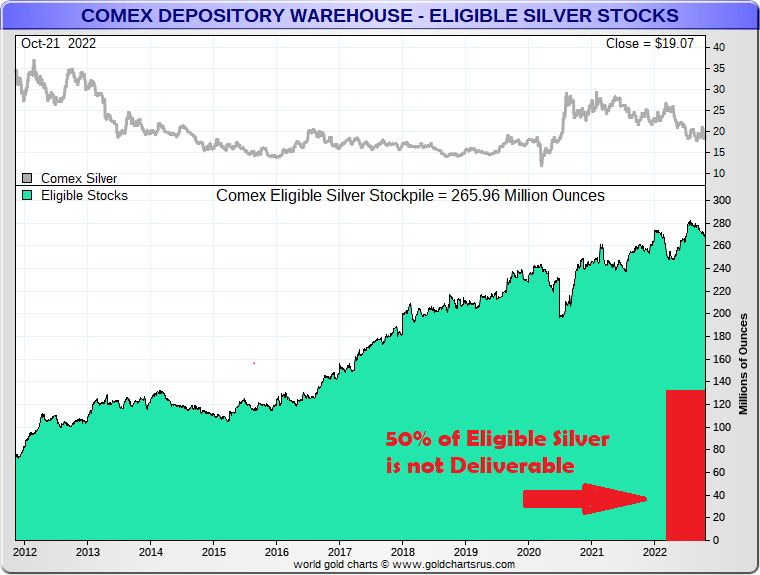
So, like in the case of COMEX gold, the COMEX operator CME does not know how much of the ‘eligible category’ silver in the COMEX approved vaults is held as ‘long term-investments’. Why does CME even assume that 50% of the eligible silver is part of deliverable supply? Why not say 40%, or 30%, or 25% is available of deliverable supply?
Why even include any eligible silver at all as deliverable supply? At the end of the day, these vaults of MTB (owned by MTS PAMP), Loomis, Brinks, Malca-Amit, HSBC, and JP Morgan – all in New York City – and Delaware Depository and IDS Delaware (both in Delaware), and CNT (in Massachusetts), are in the first instance precious metals vaults for their own clients who store their precious metals in these vaults, and in the second instance these vaults then also just happen to be COMEX-approved vaults.
If an investor purchased a 1000 troy ounce silver bar for investment purposes, and deposited this silver bar in one of the above vaults for long term storage, then it would, due to COMEX-approved vault rules, be then listed as part of COMEX eligible silver, even though the investor may never have even heard of COMEX and had no intention of trading on a futures exchange. That’s just a simple example.
SLV is 71.8% of JP Morgan’s Eligible Silver
But here is a real world example. Based on 21 October 2022 data, the iShares Silver Trust (SLV) – which is the world’s largest silver-backed ETF – states that it held 486,164,081.6 ozs of silver in the form of 1000 ozs silver bars. Of this total, 103,176,253 ozs of silver is held in the JP Morgan vault in New York, the same vault which is on the COMEX silver inventory report.
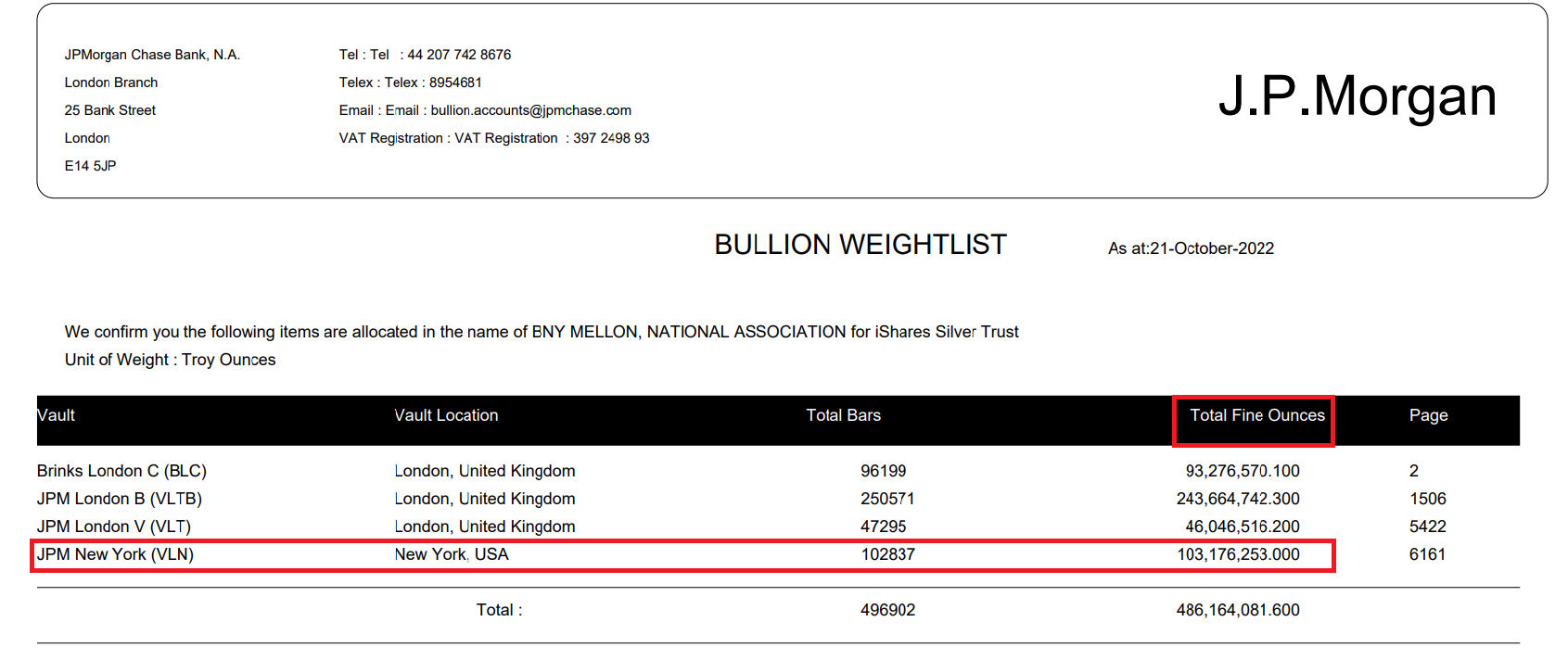
According to the COMEX silver inventory report for 21 October 2022 (see calculations above in previous table), the JP Morgan vault reported 143,694,411 ozs of silver in the Eligible category. With 103,176,253 ozs of this total held by SLV, this only leaves 40,518,158 ozs in the Eligible category of JP Morgan’s vault. In other words, 71.8% of the silver reported by the JP Morgan vault as ‘Eligible’ is already held as a long-term investment by a silver ETF, the SLV, leaving only 28.3% not held by SLV.
Of this total, SLV’s 103.176 million ozs represents 38.8% of all the COMEX claimed Eligible supply. And this is just one example. So straight away we see the magnitude of the danger in assuming that ‘Eligible silver’ is somehow connected to COMEX.
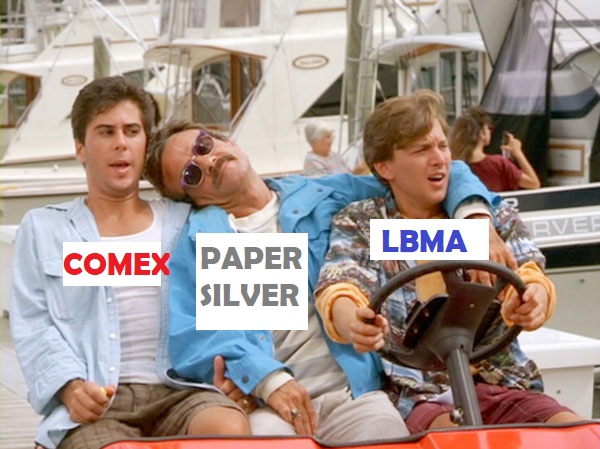
Conclusion
During September, silver inventories held in the vaults of the London Bullion Market Association (LBMA) in London fell by a massive 4.93%, and are now at a new record low. LBMA silver holdings now total only 27,101 tonnes (871.3 mn ozs), and have fallen every month for 10 straight months.
Over on COMEX in New York, the Registered silver total is now only 1186 tonnes (38.13 mn ozs), a five year low. During September, the LBMA vaults in London lost 1404 tonnes (45.166 mn ozs) , which is more silver than in the whole COMEX Registered category.
The LBMA even conceded in its latest update on silver vault stocks in London that “some contributors noted that increased client demand led to a number of physical silver exports“. The contributors here refer to the vault operators within the London LBMA market, which are HSBC, JP Morgan, ICBC Standard, Brinks, Malca Amit, and Loomis.
Nicky Shiels, precious metals analyst for MKSPAMP, echoed that view when reporting back from the LBMA’s annual conference in Lisbon last week, when she said that conference delegates predicted a “super bullish Silver [price] ($28.30!)" in a year’s time “as the focus was on physical tightness driven by unprecedented demand“. See tweet above.
An important contributor to this ‘unprecedented demand’ for physical silver is India where silver imports have been zooming ahead. Silver imports into India totalled 1812 tonnes in July, 1149 tonnes in August and initial estimates for September are about 1700 tonnes. Up until August 2022 (8 months), India’s silver imports totalled 6517 tonnes. Adding September’s ~ 1700 tonnes, gives 8217 tonnes for 9 months of 2022 so far. Which if annualised this nearly 11,000 tonnes, which is one-third of the world’s annual silver supply.
Back on COMEX, the CME’s ‘published’ silver total (where they include 100% of Eligible) is 304.1 million ozs (9458 tonnes). That figure is the lowest level ‘COMEX Eligible + Registered silver’ since 19 June 2019. But that doesn’t even include the CME’s own guidance of applying a 50% haircut on the Eligible total. When this 50% haircut is applied, the total silver in the COMEX vaults is just 171 mn ozs.
People point to the COMEX Registered silver total and say that silver can move from the Eligible category to the Registered category. But that’s not entirely true and only applies to a portion of the Eligible category. More Eligible category silver could of course come into play and move to Registered. But only at a higher silver price. With silver demand firing on all cylinders, and with demand destinations such as India securing an ever higher percentage of annual silver supply, expect the silver market to provide plenty of fireworks in the months ahead.
Popular Blog Posts by Ronan Manly
 How Many Silver Bars Are in the LBMA's London Vaults?
How Many Silver Bars Are in the LBMA's London Vaults?
 ECB Gold Stored in 5 Locations, Won't Disclose Gold Bar List
ECB Gold Stored in 5 Locations, Won't Disclose Gold Bar List
 German Government Escalates War On Gold
German Government Escalates War On Gold
 Polish Central Bank Airlifts 8,000 Gold Bars From London
Polish Central Bank Airlifts 8,000 Gold Bars From London
 Quantum Leap as ABN AMRO Questions Gold Price Discovery
Quantum Leap as ABN AMRO Questions Gold Price Discovery
 How Militaries Use Gold Coins as Emergency Money
How Militaries Use Gold Coins as Emergency Money
 JP Morgan's Nowak Charged With Rigging Precious Metals
JP Morgan's Nowak Charged With Rigging Precious Metals
 Hungary Announces 10-Fold Jump in Gold Reserves
Hungary Announces 10-Fold Jump in Gold Reserves
 Planned in Advance by Central Banks: a 2020 System Reset
Planned in Advance by Central Banks: a 2020 System Reset
 China’s Golden Gateway: How the SGE’s Hong Kong Vault will shake up global gold markets
China’s Golden Gateway: How the SGE’s Hong Kong Vault will shake up global gold markets




 Ronan Manly
Ronan Manly 0 Comments
0 Comments










